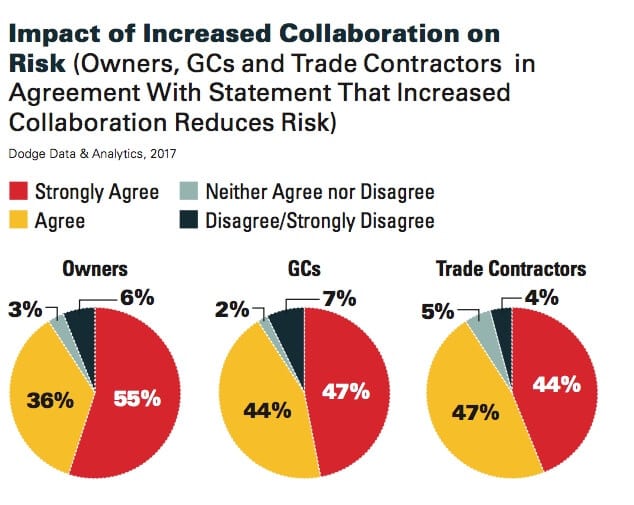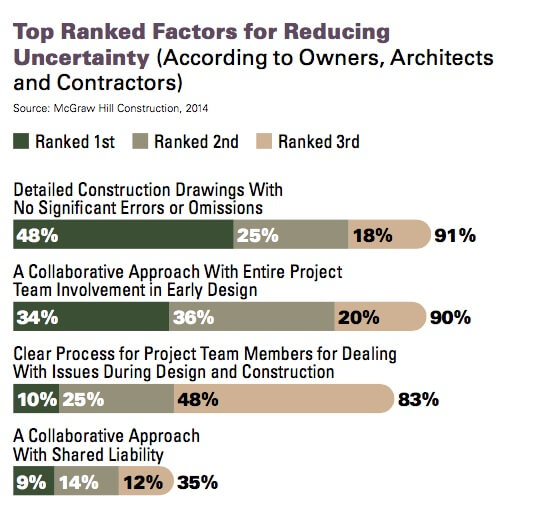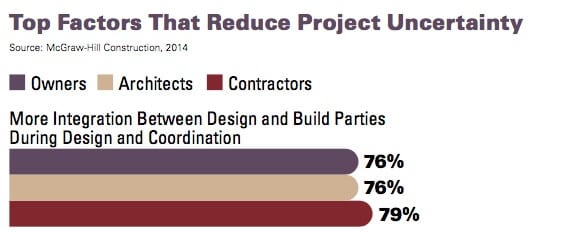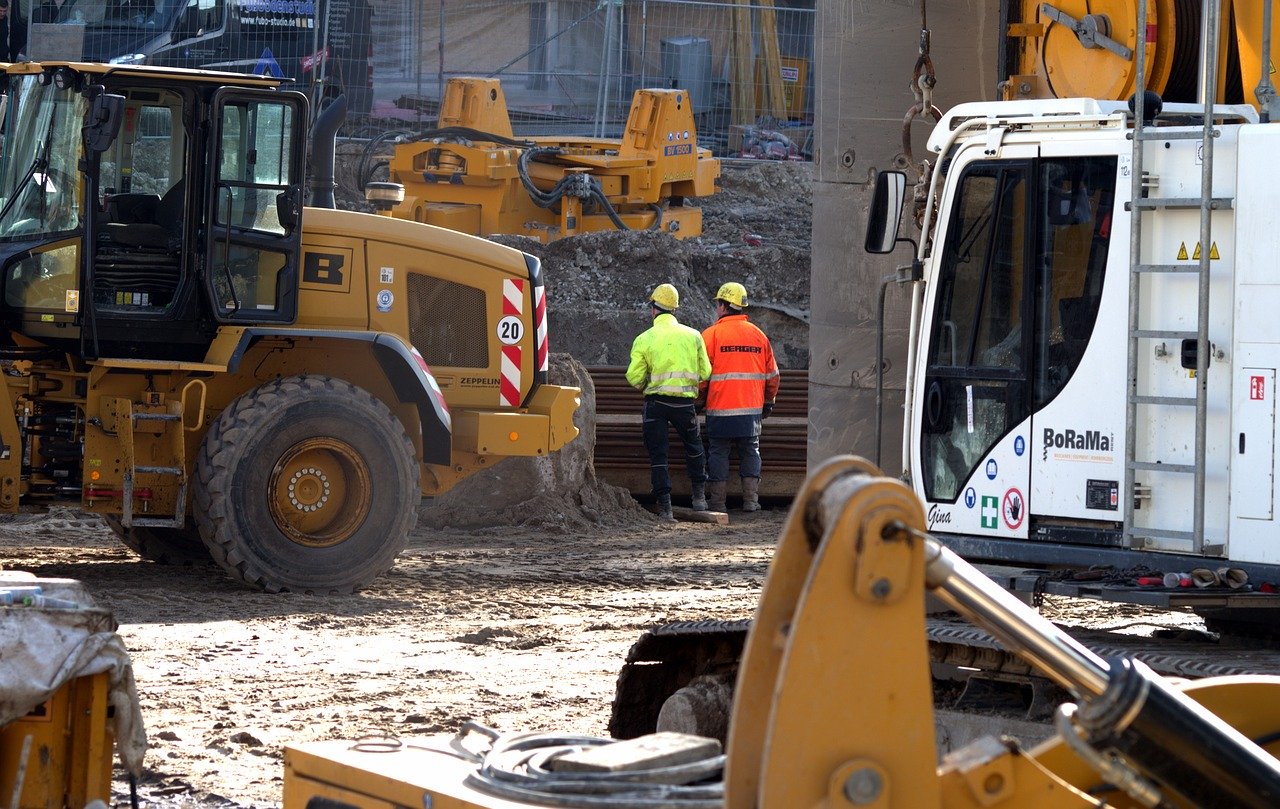Construction projects have a lot of fuss and they can easily get off track if the various parties aren’t working together efficiently. The importance of collaboration for more effective projects is increasingly recognized across the construction industry, demonstrated by the extensive research that was conducted by Dodge Data & Analytics in the last several years.

- In a recent study, 91% of contractors and owners agree that increased collaboration reduces risk on construction projects.
- In many studies about Building Information Modeling (BIM), its ability to improve multiparty communication and understanding from 3D visualization is consistently one of the top benefits reported, making it a vital tool to enhance communication.
- In another study on managing uncertainty in construction projects, over three quarters of owners, architects and contractors agree that more integration and coordination between design and build parties during the design phase significantly reduces the level of uncertainty.
Read also! 7% savings on construction projects run using GenieBelt
However, despite the widespread agreement about the value of increased collaboration, the industry still struggles to be collaborative, and it may take more than a positive attitude to overcome the challenges. Dodge’s Managing Uncertainty and Expectations in Building Design and Construction SmartMarket Report revealed an underlying bias among owners, architects and contractors that the issues they have direct control over are not the ones that contribute the most to uncertainty on projects.
For example, out of a list of seven top causes for uncertainty, architects rank design omissions seventh in terms of their impact on overall project uncertainty, while owners and contractors rank them in second place. And architects are not alone: owners and contractors also tend to follow the same pattern. This gap in perception about the fundamental causes of uncertainty about projects reveals the challenges that interfere with the industry’s ability to effectively collaborate.

That said, Dodge’s data consistently demonstrates the real value of increased collaboration. A recent study measuring owner satisfaction with projects, conducted in partnership with the Lean Construction Institute, reveals the value of improving collaboration by looking at the relationship between team dynamics and project performance. In this study, owners were asked to identify two specific projects—a best and a typical one—that they completed in the last five years based on the following four criteria: budget, schedule, quality and safety performance.
When they were asked to identify how these projects performed, a striking gap was evident between best and typical projects, especially in their budget and schedule performance:
- Almost two thirds (61%) found that their typical project came in late (based on the schedule established at the time the capital was allocated for the project), compared with just 6% who reported the same result on their best projects.
- Nearly half (46%) found that their best projects came in under budget (based on the budget determined at the time of capital allocation), compared with 49% of owners who reported that their typical projects came in over budget.
In this study, owners were also asked about what they did differently on the two projects, and the team dynamics they reported varied strongly. One of the strongest examples of this was the level of integration of the team. Sixty-one percent of owners reported that on their best projects, they had a well-integrated team, compared with just 9% who reported this on their typical projects.
If an integrated team is correlated with project success, how can that be achieved?
A few other findings lay out a road map of ways to improve collaboration on projects. One of the most striking is how early owners engage key stakeholders, including the design team, contractors and key trades.
On their best projects, over three quarters (76%) of owners reported that they engaged key stakeholders in conceptualization, compared with only 34% of owners who did the same on typical projects. These results show that early engagement of key stakeholders can help bridge the perception gap between different players that so frequently occurs in this industry and align them to the same goals.

Also, Lean construction practices that help improve team communication and integration, from the Last Planner System™ to full team onboarding and co-location, were far more frequently used on the best projects than the typical projects, proving that the industry needs to consider the value of these practices more clearly.
The benefits of BIM technology
The study also found a correlation between using BIM and better performing projects, which is echoed by many other studies. BIM’s ability to foster collaboration is consistently listed as one of its most critical benefits. In a global study of BIM use by contractors, a high percentage of contractors ranked collaboration with owners and design firms as one of the top three benefits of using 3D visualization. This was second only to reduced errors and omissions and more frequently named than reduced rework, construction cost or reduction of overall project duration.
Improved collaboration is not just a benefit from the use of BIM; it is also recognized as a critical factor for its successful implementation on projects. In the Measuring the Impact of BIM on Complex Buildings SmartMarket Report, for example, more owners and architects consider improved teamwork and collaboration to be the BIM-oriented process that contributes most to project success.
But the same findings also demonstrate that an attitude shift is needed to truly achieve collaboration through these tools: Even though most architects place a high value on improved teamwork, collaboration and enhanced communication among team members, only about one third actually see early trade- and general contractor involvement with the design team’s models as equally important as teamwork in general, a sharp contrast to owners and contractors, over half of whom value both of these approaches.
Conclusion
Taken together, these findings paint a picture of an industry seeking to improve its ability to collaborate, and one with the tools at hand to do so, from technologies like BIM to Lean construction processes. However, to truly make progress in this area and achieve better project results, it is essential that companies engage with each other very early in the project lifecycle, understand the other team members’ perspectives and share the same vision and goals for a project.
About the author: Donna Laquidara-Carr, Ph.D., LEED AP, Research Director for Industry Insights at Dodge Data & Analytics




